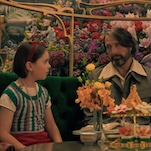Anna Kendrick has done plenty of singing on film, from her memorable teenage performance of Stephen Sondheim’s “Ladies Who Lunch” in the semi-musical Camp to her a cappella stylings in Pitch Perfect and a supporting role in last year’s Into The Woods. But in The Last Five Years, she finally has an unequivocal lead role in an unequivocal on-screen musical: The movie, an adaptation of a short-lived but cult-loved off-Broadway show, has only two real parts, and far more songs than dialogue.
The movie begins with Cathy (Kendrick) at the end of a five-year relationship with Jamie (Jeremy Jordan), singing plaintively and almost stock-still as the camera circles her. The next song is more exuberant, because the movie cuts to Cathy and Jamie on an early date, with Jamie singing about his new “Shiksa Goddess.” From there, Cathy’s story and songs proceed backward through their relationship, while Jamie’s material barrels forward. Amid giddy moments of affection, Jamie’s early and unlikely success as a writer bumps up against Cathy’s stalled career as an actress (a recurring signpost: the annual time she spends outside their New York home, doing summer stock in Ohio).
Through the good times and the bad, writer-director Richard LaGravenese keeps his focus tight, even when taking advantage of an on-screen musical’s stylistic versatility. The handheld camera doesn’t shake so much as hover around the characters, not unlike Terrence Malick’s recent films; it shows its loyalty to Cathy, Jamie, and no one else. Technically, other people appear on screen, but they’re almost all extras of one sort or another, even (or especially) when they glide into little imitations of production numbers around the stars. Many of the numbers stay in a single room, but several utilize the movie’s small-scale freedom to blend realism and homemade whimsy—especially “A Summer In Ohio,” which deftly depicts Cathy on video-chat with Jamie, in slapdash rehearsals for various musicals, and gossiping backstage.
Cathy and Jamie are often present for each other’s numbers, but they don’t usually sing together. Dividing the songs and timelines is a bold and thematically strong idea maintained from the original show, but in practice it means that the two lead characters spend most of the movie singing de facto monologues. Often they’re ghosts in each other’s solos, which makes the movie both haunting and a little repetitive—especially when all of the details must come from these songs, not a full immersion into the characters’ worlds (especially not Jamie’s writing career, the portrayal of which is, like many professions distilled by musical theater, murky at best).
The couple does perform a genuine duet when the two timelines intersect in the middle of the film, and for a few scenes afterward, their two stories smudge into each other, unsticking the movie in time. Whether intentional or not, the confusion makes a poetic sense. But the pivotal crisscross also tips the movie out of balance. What skews it most dramatically is the fact that Cathy generates more empathy than Jamie, thanks both to Kendrick’s charisma and Jamie’s tiresome bro-artist routine. Kendrick sings her heart out and also proves a great reactor, managing to steal a couple of scenes from Jordan even when he’s the one singing. Jordan, meanwhile, gets stuck playing a guy who spends an inordinate amount of time whining about his partner’s lack of enthusiasm for book-party attendance. The material initially addresses his hubris via the early song “Moving Too Fast,” a heady rush of excitement and surging ego. But in later scenes, his unreasonable complaints undermine, rather than deepen, his relationship with Cathy.
That relationship ultimately doesn’t produce five years’ worth of complexity; it’s all too easy to condense down to 95 minutes. But scene for scene, The Last Five Years is more often affecting than not. For LaGravenese, Kendrick, and Jordan, it probably qualifies as a small but intense labor of love. For Kendrick in particular, it’s a sign that she could sing her way through something bigger.









































